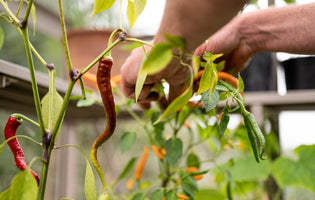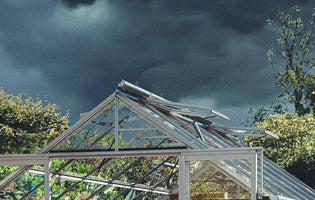If there’s one thing that can seriously affect the beauty of your roses, it’s rain damage. With increasingly hard-to-predict weather patterns, our rose protection tips will keep them looking their best, come rain, come shine.
It’s getting more and more difficult to predict the weather these days. And a particularly wet year can cause havoc to your prized plants. Luckily, between pruning and regular plant maintenance, there are plenty of ways you can equip your roses to deal with rainwater.
Understanding the impact of rain on roses
While rain is usually welcome in the garden, too much can be a bad thing for some plants. Excessive downpours can lead to issues with roses, such as:
Waterlogged soil: Too much water can suffocate roots and cause roses to rot from the bottom up.
Fungal diseases: Continuous rain creates the ideal conditions for mold and diseases like black spot and powdery mildew, which can damage leaves and stems.
Flower balling: Wet weather can prevent rose buds from opening at all; instead the petals rot and form a ball.
Fewer blooms: Too much water can stall photosynthesis, reducing plants’ ability to produce flowers in the first place.
Physical damage: Storms, high winds and heavy rain can weaken roses by breaking stems and scattering petals.
Rain protection for roses
There are a number of actions you can take to ensure your roses are protected from rain damage.
Choosing the right location
The best time to plant roses is from September to November, before the first frost, or between February and May, once all chance of frost has passed.
While it’s well-known that hungry roses like fertile ground, before you plant them, take time to ensure their roots get settled into well-drained soil. If the ground is heavy clay, add a spade of grit (as well as some well-rotted, nutrient-rich manure) to the planting pocket as you back-fill it. This will ensure water doesn’t sit around the base of the plant, cutting off air supply to the roots.
Aspect is also important. If you can, select a spot for your rose that offers some natural protection from heavy rain, perhaps alongside a wall or fence.
Implementing physical barriers
Similarly, you can offer roses long-term protection by planting them against a garden structure such as a pergola or an arbor. The plants will grow up and over the structures, covering them in flowers; at the same time, they’ll benefit from being shielded from the elements.
As a temporary measure, try shielding roses from rain by covering them with garden umbrellas, tents or covers. This can be a good short-term solution if squalls, storms or unexpected downpours are forecast.
Pruning and maintenance
Pruning roses is essential; it gives your plants structure and encourages more blooms, as well as helping to keep your plants healthy and protected.
The best time to prune roses is in late winter or early spring, just as new growth is starting to appear. By removing dead wood and improving the shape of the plant, you’ll improve air circulation and reduce the risk of disease.
Climbers. Patio roses. Hybrid Teas. Different types of roses will need pruning in slightly different ways. It’s best to look up the particulars for each type as you need to know them but, in general, a good way to prune your roses is to:
- Start by removing any dead, diseased or dying stems by cutting them back to the base.
- Next, remove any stems that are crossing or tangled. This will help to improve air circulation and prevent diseases.
- Prune healthy stems back by about one-third to encourage new growth and give the plant a pleasing shape.
- Dispose of your pruning - in the bin rather than the compost heap - to prevent the spread of any fungal diseases.
Alongside annual pruning, regular maintenance throughout the year will help to keep your roses in tip-top condition. Deadheading flowers and removing diseased leaves will ensure the plant stays in peak health and is better able to withstand inclement weather.
Applying protective sprays
While roses’ disease resistance has improved greatly over the years, they can still be susceptible to fungal infections, and this can be exacerbated by heavy rain.
Some people use fungicidal sprays and other treatments to protect roses from diseases such as blackspot, rust and powdery mildew. They can be applied as soon as you spot the first signs of infection, to control the symptoms and save the leaves of your plants. Some fungicides are certified for organic gardening; it’s best to check the bottle before use.
The RHS, however, doesn’t recommend using fungicides at all, as they, ‘may reduce biodiversity, impact soil health and have wider adverse environmental effects’. Instead - as we suggest above - they recommend non-chemical controls, starting with environmental management (such as where the rose is planted in the first place), soil management and humidity management, i.e. promoting good air circulation around your plants and avoiding overwatering.
In short: if you follow this advice first, you shouldn’t need to resort to chemical use at all, as you’ll already have happy, healthy roses that can withstand whatever nature throws at them.







